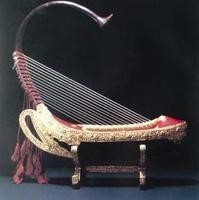phoenix head konghou overview
 Fengshou Konghou (pinyin: fèng shǒu kōng hóu) is a plucked stringed musical instrument of the ancient southwestern ethnic minorities in my country. The phoenix-headed Konghou is also called "Sangke" in Southeast Asia, and it was called "General Manuscript Machine" in the Qing Dynasty. It is mostly used in court ceremonies and music, and is relatively rare in the folk, and was once lost.
Fengshou Konghou (pinyin: fèng shǒu kōng hóu) is a plucked stringed musical instrument of the ancient southwestern ethnic minorities in my country. The phoenix-headed Konghou is also called "Sangke" in Southeast Asia, and it was called "General Manuscript Machine" in the Qing Dynasty. It is mostly used in court ceremonies and music, and is relatively rare in the folk, and was once lost.In the early 4th century AD, it was introduced into the Central Plains; in the Sui and Tang dynasties, it was mostly used for court rituals and music, and was popular with the noble class; in the late 14th century, it was completely lost in China, and a small amount was circulated in the Pyu Kingdom (now Myanmar). Donated a phoenix head konghou to be collected in the China Musical Instrument Museum of the Music Research Institute of the Chinese Academy of Arts in Beijing.
In the 4th century AD, at the beginning of the Eastern Jin Dynasty, the phoenix-headed Konghou was introduced to my country from India along with Tianzhu music. During the Sui and Tang Dynasties, the phoenix-headed Konghou was mostly used in court ceremonies and music. It is used in both and Shule music, especially Pyuguo music was popular among the ancient aristocratic classes in my country, and the phoenix head Konghou was used as a court ceremonial music.
In the late 14th century, the Fengshou Konghou was completely lost in China. In the early 1930s, the Datong Music Society, a well-known ethnic music society in my country, began to try to restore the phoenix head Konghou, but due to war or other reasons, it could not be passed down to modern times, and only photos of the musical instruments were left.
- Chinese name:phoenix head konghou
- nickname:Finalizer
- category:plucked string instrument
- production time:1930s
- Features:Luxurious decoration, soft sound
- Pinyin:fèng shǒu kōng hóu
overview of other similar instruments
- sanyanxiao overview
- Daguangxian overview
- Leiqin overview
- hahao overview
- yandundagu overview
- Han Xiaozheng overview
- Fang Xiang overview
- guanzi overview
- zhuqin (Dao Qin) overview
- zhuiqin overview
- bangzi overview
- three-stringed piano overview
- Gehu overview
- xiao overview
- xiaokonghou overview
- Konghou overview
- Sheng overview
- suona overview
- hulusi overview
- gushao overview
 渝公网安备 50010702504639号
渝公网安备 50010702504639号